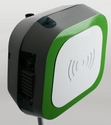Linux-powered mesh gadget buffs up
Oct 26, 2007 — by Eric Brown — from the LinuxDevices Archive — 6 views Saxnet has introduced a major upgrade of its Debian Linux-powered Meshnode wireless mesh-networking router. The Meshnode III boasts increased WiFi transmit power and a self-organizing four-radio transmission system, among other enhancements.
Saxnet has introduced a major upgrade of its Debian Linux-powered Meshnode wireless mesh-networking router. The Meshnode III boasts increased WiFi transmit power and a self-organizing four-radio transmission system, among other enhancements.
digg this story |
When LinuxDevices last checked in with this Oelsnitz, Germany-based networking equipment integrator in February of 2006, Saxnet was called Saxonia, and its Meshnode was a modest dual-module affair. Meshnode III, however, is equipped with four “OSI Layer 2-compatible” radio modules, each capable of transmitting data at up to 600mW. Saxnet says this extra power translates into greater mesh coverage, and more potential clients, though it did not offer further specifics.




Several views of the Saxnet Meshnode III
(Click each thumbnail to enlarge)
Saxnet claims the device meets IP69K protection-class standards, with a heating and cooling system that can protect against temperatures from -40 to +70 degrees C. A new 10.2 x 6.9 x 1.9-inch (260 x 175 x 49 mm) add-on compartment supports installation of client-specific hardware, and the device's dual-slot CompactFlash expansion supports up to 16GB per module, enabling integration of a wide range of Linux software. The straightforward x86/Debian platform should further help to streamline development on the platform.
Mesh: instant, ad hoc infrastructure
Wireless mesh networks such as Meshnode III, the Meraki Mini, or the Marvell Libertas controller and radio built into the One Laptop per Child XO system enable users of the devices to quickly create daisy-chain networks in areas lacking infrastructure. Each router can serve as a repeater for the other routers, letting users extend the range from the wired network drop simply by adding more devices, creating a “mesh” of overlapping radio coverage areas.
The Meshnode III's four radios communicate with each other to determine which can most efficiently transmit a given signal, reports Saxnet, and in most configurations, the nodes can choose different routes of transmission to optimize bandwidth. If a node goes out, the network can usually redirect transmissions via another path. The company says the system also supports hand-offs between nodes, permitting roaming for mobile devices. Data security is provided via WPA encryption.
Mesh to the rescue
Saxnet says the Meshnode III can be used in place of any wireless LAN, connecting notebooks, surveillance cameras, VoIP phones, and other devices. It's said to be particularly well-suited for temporary configurations, such as trade shows, public events, or first-responder situations. For example, Meshnode III enables rescue workers to immediately establish an ad hoc local network connected to a satellite modem.
The company also touts applications including maritime use in harbors and any operation with harsh environmental conditions. In manufacturing, mesh nodes are increasingly being used for surveillance and automation-and-control applications in factories where Ethernet wiring is difficult to install and WiFi LANs can be disrupted by interference. Mesh networks can work around interference via alternate routes.
Meshnode III specifications
The Meshnode III's specs are listed as follows:
- CPU — AMD Geode (X86) LX 700 (standard), 800, 900
- Memory:
- 256MB RAM, expandable to 1GB
- CompactFlash — two 512MB flash cards, expandable to 16GB each
- LAN:
- 1 x 10/100 Mbps Ethernet
- 1 x 10/100/1000 Mbps Ethernet
- WLAN:
- 802.11a/b/g (5GHz/2.4GHz/2.4GHz, respectively)
- Transmit power — 100 to 600 mW
- Aerial ports — 8 x N-female (4 x diversity)
- Meshing technology:
- OSI Layer 2 with ad-hoc and infrastructural mode
- Aggregate data rate — up to 108Mbps with SuperA encodings (WEP/WPA/WPA2)
- Other I/O ports:
- 2 x USB 2.0
- 2 x serial ports
- I2C
- VGA video
- Expansion:
- 2 x CompactFlash slots
- 4 x Mini PCI sockets
- 50 digital I/O lines (optional)
- Physical:
- Housing — water- and UV-resistant Makrolon
- Dimensions — 10.2 x 7.9 inches (260 x 200 mm); 13.8 x 13.4 inches (350 x 340 mm) with sun protector
- Operating temperature — -40 to +70 degrees C (@ 95% humidity)
- Operating system — Debian GNU/Linux, with 2.6.21 kernel
Availability
Saxnet said it will demonstrate the Meshnode III at the Systems Fair 2007 in Munich, Oct. 23-27. The device is expected to be available by the end of January, 2008. It will be priced around 800 Euros (approx. $1,150) with four WiFi cards, a spokesperson said.
This article was originally published on LinuxDevices.com and has been donated to the open source community by QuinStreet Inc. Please visit LinuxToday.com for up-to-date news and articles about Linux and open source.